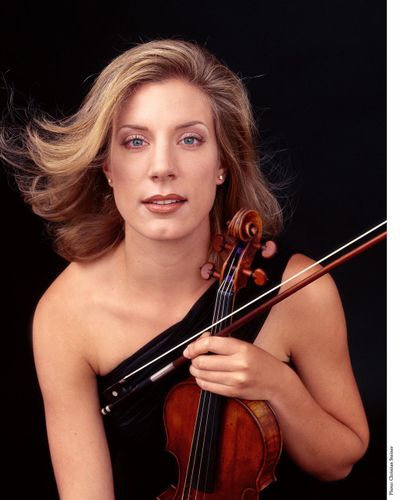The Red Violin’s journey continues to Spokane this weekend

Not many instruments are prestigious enough to have inspired their own feature film. The Mendelssohn Stradivarius, popularly nicknamed “the red violin,” did just that.
This weekend, the legendary “Strad” will be in Spokane with its current owner, internationally celebrated violin virtuoso Elizabeth Pitcairn. She will play John Corigliano’s “Chaconne from ‘The Red Violin’ ” in two concerts with the Spokane Symphony Orchestra under the baton of Morihiko Nakahara, resident conductor and a finalist in the symphony’s music director search.
François Girard’s 1998 film, “The Red Violin,” scored by Corigliano, outlines the director’s musings on the journey this storied violin might have taken in the nearly 200-year period when it was assumed lost. The film’s red violin takes an extensive and multinational journey through a diverse cast of musicians until landing on the podium of a British auction house.
In 1990, Pitcairn’s grandfather quietly bought the real Mendelssohn Strad at auction for a reported $1.7 million and gave it to her when she was just 16 years old. At the time, she was already a talented young violinist.
“The violin had been in a private collection for 45 years. So, no one had really had access to see it or hear it. But (my mother) knew the right people in the music world,” Pitcairn said. “She made special arrangements with the auction house to take me over to London to try the violin.
“Then I didn’t see it for about a year after that. I went off to college in the fall of ’90; my parents didn’t think the freshman dorm was the right place for a Strad.”
Pitcairn and her family remained silent about the gift until her own talent and international solo career brought her into the public eye.
“I think it made a lot of sense to be able to develop naturally in my own career, at the right pace,” Pitcairn said. “Then, when it did come out, it was because we had sort of grown at the same pace.”
At that time, Pitcairn and her family knew only a fraction of the instrument’s history. She was totally unaware of the relation it held to the Girard film when she first began learning Corigliano’s “Chaconne for the Red Violin.”
“I was by chance playing the music,” Pitcairn said. “We didn’t even know there was a connection and I was one of the first few people to ever play the violin chaconne (almost) 18 years ago.”
Pitcairn, already in demand as a soloist, had been asked to learn Corigliano’s chaconne for its Southern California premiere.
“The L.A. Times reviewed the concert and they said ‘Elizabeth was playing on the red violin, a coincidence we’re told,’ ” Pitcairn remembered.
Before Pitcairn, ownership of the real “red Strad” is traced to 1930s Berlin and to Lili von Mendelssohn, a descendent of the early romantic German composer Felix Mendelssohn. But, previous to Mendelssohn, the owner history is all but untraceable from the time it left Antonio Stradivari’s workshop in Cremona, Italy in 1720.
Coincidentally, Pitcairn and Mendelssohn share more than a love for the same violin.
“Come to find out after all these years, Lili is a nickname for Elizabeth,” said Pitcairn. “She was the only other known woman to play this instrument, and we both have the same name.”
The violin itself has several nicknames, but Pitcairn and close friends affectionately refer to it as “Felix” in honor of the composer and his family’s connection to the instrument.
“In the film the violin is haunted by the soul of a woman,” Pitcairn said . “People ask me if I consider my violin to be masculine or feminine, and I always say it’s like a masculine entity with the soul of a woman.”
Saturday and Sunday, the symphony will bookend Pitcairn’s performances with Tan Dun’s “Symphonic Poem on 3 Notes” and Pyotr Ilyich Tchaikovsky’s Symphony No. 5.
Nakahara wasn’t involved in the programming process for the concert, but he was immediately excited about the lineup. He sees connections between the three works, beginning with the composers.
Tan and Corigliano both were brought up in the more traditional, classical world but nevertheless have worked a fair bit in film scoring. Both won Oscars for their film music, Corigliano for “The Red Violin,” and Tan for “Crouching Tiger, Hidden Dragon.”
Tan’s “Symphonic Poem on 3 Notes” is a traditional concert piece, but a fairly eccentric one. The score, much to the orchestra’s initial chagrin, calls for singing and shouting at certain moments.
“It’s sort of a joke,” Nakahara said. “It was written as a sort of tongue in cheek element of the piece, that the three notes he chose are “a,b,c” or in sollfege its “la, si, do.” That’s sort of the musical backbone of the piece. It was written as a birthday gift to Placido Domingo; when you hear the name “Placido” fast you sort of miss the “p” so you get a lot of the “la-si-do, la-si-do” when the orchestra gets going.
“(It) evokes this spirit of something that might be seen in Beijing opera (or) Peking Opera,” Nakahara said. “There are a lot of sort of ritualistic elements to (Tan’s work).”
Tchaikovsky’s Symphony No. 5 “is one of the most beloved romantic symphonies of all time,” Nakahara said. “It’s one of those pieces that has such sweep and drama and … it’s a great piece to show off the orchestra with all of the great solo writing and also the whole power that he can unleash from the entire orchestra or (even just) sections of the orchestra.”
Pitcairn will also be giving a masterclass for three or four selected local student violinists at the Fox from 3 to 5 p.m. today. The masterclass is free and open to the public.
This article has been updated to reflect the correct lowest ticket price.